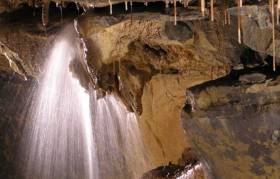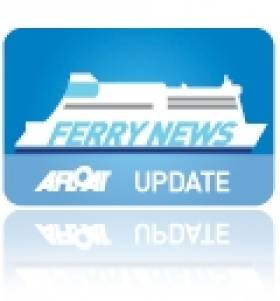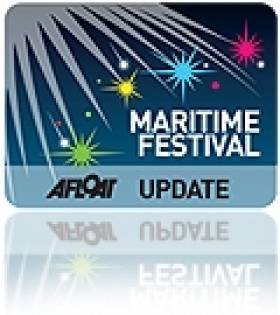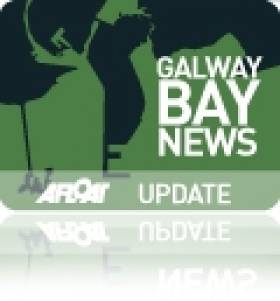Displaying items by tag: Burren
The Burren Rocks This May
A series of fun and educational events exploring how the history, culture, flora and fauna of the Burren have been shaped by the region’s geology will take place as part of ‘The Burren Rocks 2016’ in County Clare on May 28th and 29th.
The annual programme of events is organised by Burren and Cliffs of Moher UNESCO Geopark, with the support of Doolin Cave, eWhizz, Adventure Burren, Aillwee Cave and the Burren Outdoor Education Centre, and forms part of European Geoparks Network Week 2016.
This year's festival features an archaeology cycle tour of the Burren, rock climbing, nature walks, birds of prey flying display and caving. One of the highlights of this year’s programme is a weekend long series of events celebrating 40 years of Aillwee Cave with walks, talks and an exhibition of ancient bear remains taking place on Aillwee mountain.
Carol Gleeson of Burren & Cliffs of Moher UNESCO Geopark explained that the festival "explores the underlying geology of the Burren and how it holds many fascinating clues to conditions on Earth during the past 300 million years, including the end of the last Ice Age 12,000 years ago which gave the Burren its current shape."
Ms. Gleeson added, "The Burren Rocks Festival combines outdoor activity and adventure with geology and the landscape. The public is invited to discover fascinating landmarks and important geological sites all over the Burren, above ground and below, whether that is by walking, cycling, hiking, climbing or kayaking the area."
The festival gets underway on Saturday 28 May at 9.30am with 'Rock Climbing in the Burren', hosted by the Burren Outdoor Education Centre (bookings 065 7078066)
At 11am, e-Whizz will host a guided bike ride (bookings 087-6277000) through the archaeological landscape of the Burren starting at Aillwee Cave and taking in the sites of Cahermore, Cahermacnaghten and Poulnabrone.
The Burren Outdoor Education Centre is inviting the public to explore the underground stream ways of the Burren in a caving outing (bookings 065 7078066) at 2.00pm.
At 4.00pm there will be a Birds of Prey Flying Display at the Burren Bird of Prey Centre (bookings 065 7077036).
On Saturday and Sunday (28-29 May), ancient bear remains from the National History Museum will be placed on public display at Aillwee Cave where there also will be 30-minute tours of the cave each day. Nigel Monaghan, keeper of the Natural History Division of the National Museum of Ireland, will give a talk on Brown Bears in the Irish Ice Age on Saturday at 3.00pm.
On Sunday at 10.00am, Adventure Burren will take walkers off the beaten track to explore ancient monuments and wallscapes (bookings 087-2244569).
Aillwee Cave at 1.00pm will see Edward, Aillwee’s resident bear, celebrating his landmark birthday with a teddy bears picnic for all the family to enjoy.
Doolin Cave will host its "From daylight to stalactite" tour at 2pm. The tour (bookings 065-7078066) takes in the various rock formations and diverse flora that are unique to the Burren.
The Burren Rocks 2016 concludes at 4.00pm with a Birds of Prey Flying Display at the Burren Bird of Prey Centre.
"The Burren Rocks programmes proves that learning about our history and landscape can be fun and exciting, especially here in the Burren. Where else can you learn climb a mountain or two, or take a stroll through some of Ireland’s most stunning nature? All the while learning how the Burren was formed millions of year ago and how it use to lie at the bottom of an ocean," said Ms Gleeson.
Burren Ferry To Boost Galway Bay Tourism
#FerryNews - Today (Saturday 18 April) sees the launch of a new passenger ferry service across Galway Bay between the city and the Burren.
As the Clare Champion reports, the new ferry routes – which will see boats sail between Galway and the villages of Ballyvaughan and Kinvara on alternate days – are operated by MacMara, a new coastal ecotourism business.
MacMara founder Michael McArdle was part of the Ballyvaughan Bay Hop project, which ran a fast ferry service between the Burren and Galway City to coincide with the Volvo Ocean Race finale.
That feasibility study fed into the new service, which fellow Bay Hop operator Gwen Ryan has been refocused from commuting to "leisure travellers and bringing people from Galway City to the Burren and South Galway."
It's also expected that the MacMara service will open more of the Galway Bay coast to the tourism opportunities afforded by the Wild Atlantic Way initiative.
The Clare Champion has much more on the story HERE.
#maritimefestival – Food critic Sally McKenna, TV chef Darina Allen and food writer Dr. Prannie Rhatigan are among the participants in the 2014 Burren Slow Food Festival, which takes place tomorrow and Sunday.
Supported by the Burren & Cliffs of Moher Geopark and also featuring members of the Burren Food Trail and the Burren Adventure, the 8th annual festival is being held at various venues throughout Lisdoonvarna, Co. Clare.
As Afloat.ie reported recently, Seaweed is a common theme across the Festival Programme this year.
Author of "Irish Seaweed Kitchen", Prannie Rhatigan GP is hosting a demonstration and talk on how the thousands of tonnes of seaweed washed up on Irish coastline each day can be exploited for their potential as a foodstuff.
Meanwhile, Sally McKenna of John and Sally McKennas' Guides (formerly The Bridgestone Guide) and Stefan Kraan, author of "The Science and Gastronomy of Umami", will be discussing the benefits for Ireland's seafood industry in harvesting seaweed.
The festival also features food sampling of local artisan foods, a chance to meet local producers and growers, engage with fellow foodies, and enjoy cookery demonstrations from well-known chefs including Jess Murphy, Kai Restaurant, Galway; John Sheedy, Sheedy's, Lisdoonvarna; and Aidan McGrath, Wild Honey Inn, Lisdoonvarna.
Other highlights of the weekend include a talk by Slow Food Ireland President and chef Darina Allen; a Wild Food Foraging Walk hosted by Oonagh O'Dwyer from Wild Kitchen in Lahinch; and a demonstration of the essential skills of making handcrafted fine chocolates by Burren Chocolatier and Burren Food Trail Kasha Connolly.
The main festival banquet on Saturday night will be prepared by Vivian Kelly of Kierans Kitchen at the Roadside Tavern who will serve Gleninagh Lamb, Burren Smoked Irish Organic Salmon, desserts from Fabiola's Pâtisserie and wines from Burren Fine Wine & Food.
Seaweed Theme in Burren Slow Food Festival
#slowfood – Food critic Sally McKenna, TV chef Darina Allen and food writer Dr. Prannie Rhatigan are among the participants in the 2014 Burren Slow Food Festival, details of which were announced today.
Supported by the Burren & Cliffs of Moher Geopark and also featuring members of the Burren Food Trail and the Burren Adventure, the 8th annual festival takes place in Lisdoonvarna, Co. Clare, on the weekend of 24-25 May.
Seaweed is a common theme across the Festival Programme this year.
Author of "Irish Seaweed Kitchen", Prannie Rhatigan GP is hosting a demonstration and talk on how the thousands of tonnes of seaweed washed up on Irish coastline each day can be exploited for their potential as a foodstuff.
Meanwhile, Sally McKenna of John and Sally McKennas' Guides (formerly The Bridgestone Guide) and Stefan Kraan, author of "The Science and Gastronomy of Umami", will be discussing the benefits for Ireland's seafood industry in harvesting seaweed.
The festival also features food sampling of local artisan foods, a chance to meet local producers and growers, engage with fellow foodies, and enjoy cookery demonstrations from well-known chefs including Jess Murphy, Kai Restaurant, Galway; John Sheedy, Sheedy's, Lisdoonvarna; and Aidan McGrath, Wild Honey Inn, Lisdoonvarna.
Other highlights of the weekend include a talk by Slow Food Ireland President and chef Darina Allen; a Wild Food Foraging Walk hosted by Oonagh O'Dwyer from Wild Kitchen in Lahinch; and a demonstration of the essential skills of making handcrafted fine chocolates by Burren Chocolatier and Burren Food Trail Kasha Connolly.
The main festival banquet on Saturday night will be prepared by Vivian Kelly of Kierans Kitchen at the Roadside Tavern who will serve Gleninagh Lamb, Burren Smoked Irish Organic Salmon, desserts from Fabiola's Pâtisserie and wines from Burren Fine Wine & Food.
#burren – The successful management and promotion of the Burren and Cliffs of Moher Geopark as a sustainable destination has been officially recognised by one of the world's foremost tourism and travel award schemes.
The World Travel & Tourism Council (WTTC) has named the Geopark as one of 18 finalists for its 2014 Tourism for Tomorrow Awards, the winners of which will be announced at a tourism summit in Hainan, China tomorrow (Thursday, 24 April 2014).
Carol Gleeson, Project Manager for Burren and Cliffs of Moher Geopark has travelled to China for the WTTC ceremony and tourism summit which is also being attended by Minister for Transport, Tourism and Sport, Mr Leo Varadkar TD.
The Tourism for Tomorrow Awards are one of the highest accolades in the global Travel & Tourism industry recognising sustainable tourism best practices in businesses and destinations worldwide, ranging from local destinations to global hotel groups, international airlines, luxury tour operators and small eco-lodges.
Award applications were received this year from 56 countries, representing all continents. The Burren and Cliffs of Moher Geopark has been shortlisted alongside Bonito (Brazil) and Temes S.A. - Costa Navarino (Greece) as 'Destination Award' finalists for "showing commitment to supporting and delivering sustainable tourism best practices in their destinations."
Speaking ahead of tomorrow's ceremony in Hainan, Carol Gleeson said the award nomination is testament to the partnership approach to promoting sustainable tourism in the Burren that has been developed by regional development agencies and the local community.
She explained: "Since 2008, Clare County Council has been working in the Burren to develop a truly sustainable tourism destination that gives direct benefits to the local community, promotes and celebrates local culture and produce, preserves the environment and provides a great experience for our visitors. This has been achieved with great support and partnership from local communities and businesses and agencies responsible for tourism and conservation and local development."
"This work includes establishing the Burren Ecotourism Network as far back as 2008, achieving UNESCO recognised Global Geopark status in 2011 and providing environmental and business training, developing a destination brand, promoting certification, and importantly linking high responsible tourism standards with economic benefit to the area. The Geopark has also attracted €2.2m funding through the EU Life programme to develop an international sustainable tourism destination model," Ms. Gleeson added.
According to Costas Christ, Chairman of the Judging Panel: "Each year, the Tourism for Tomorrow Awards recognize sustainable tourism best practices in action, helping to transform the Travel & Tourism industry based upon the principles of environmentally friendly operations, support for the protection of cultural and natural heritage, and direct benefits to the social and economic well-being of local people in travel destinations around the world. This year's Finalists continue to demonstrate that when carefully managed, tourism can be a powerful force for improving livelihoods and protecting our planet for future generations."
Further information on the Burren & Cliffs of Moher is available on www.burrengeopark.ie.
Historic Trophy for South Pacific Dream Cruise
Fergus and Kay Quinlan live in the Burren in County Clare, and in 1997 they launched the steel van de Stadt 12-metre cruiser Pylades, which they'd built themselves. They've made several voyages and have been in the Irish Cruising Club's award list before. But at the ICC's AGM in the National YC on February 18th they deservedly got the big one, the Faulkner Cup, for the first stage of a global circumnavigation which began from their home port of Kinvara in the summer of 2009, and a year later they'd reached Tahiti.
Their cruise continues, so the award was made in absentia. Adjudicator Brian Cudmore of Cork made the point that their informative log included much general and often entertaining information, and it becomes even more interesting the further you got into it, so he's keenly anticipating the next inmstalment.
The Strangford Cup for an alternative best cruise could not have been more different, both in location or boat type. The 44ft Young Larry may have been built of steel in 1995, but she was based fairly precisely on the design of a gaff cutter built in 1907. And though the rig has been made more manageable through being a yawl, even the mizzen is gaff-headed, while the main sets a topsail. Not the most-easily handled rig for challenging seas, you might well think, but Maire Breathnach (originally from Dungarvan) and her partner Andrew Wilkes, crewed by Maire's niece Sibeal Turraoin, took Larry Og – which looks for all the world like a smaller Asgard I – right through the Northwest Passage to Alaska, an extraordinary one-season achievement.
The ICC members logged some other notable Atlantic voyages, with Michael Coleman of Cobh, a Port of Cork Pilot before he got the free bus pass, making a fine Atlantic triangle to the Azores, then Newfoundland, and so home to Cork, visiting many islands with his well-found 1988 Oyster 53 Oyster Cove. It was all done with a crew of average age 66, senior member Tom Noonan aged 76, and worthy winners of the Atlantic Trophy.
Over the years since its foundation in 1929, the Irish Cruising Club has become the trustee and adjudicator of many trophies, twenty in all, and two of them were special presentations in 2010. The Donegan Memorial Trophy went to Ruth Heard, an ICC member since 1967. She has cruised both to the Azores and Iceland, but is honoured this year in celebration of her remarkable contribution to the rebirth of the inland waterways, and to mark the re-opening of the Royal Canal. Ruth Heard was on the crew of Harklow, the last boat to transit the Royal in 1954 before its half century of official closure which was gloriously reversed in 2010.
And once upon a time, the ICC was the organiser of Ireland's Admiral's Cup campaigns. Though many members still race offshore as individuals, the club has long since focused totally on cruising. But it has a general trophy, the John B Kearney Cup for Services to Irish Sailing, and for 2010 it was awarded with acclamation to the successful Irish Commodore's Cup Team.
- Faulkner
- Cruise
- Cruising
- Cup
- Club
- Quinlan
- Kay
- Fergus
- ICC
- National
- yacht
- cub
- YC
- Cudmore
- Cork
- Breathnach
- Alaska
- Asgard I
- Strangford
- Burren
- Pylades
- Northwest
- Passage
- Wilkes
- Sibeal Turraoin
- Coleman
- Atlantic
- Cobh
- Newfoundland
- Oyster Cove
- Oyster
- Donegan
- trophy
- Ruth Heard
- John B Kearney
- Cup
- Commodore's
- gaff
Ferry Link Could Halve Journey from Burren to Galway
Galway city could see a new ferry link with the Burren in Co Clare, pending a feasibility study.
The proposed 'Ballyvaughan Bay Hop' ferry could see the travel time between the two locations halved, and could be ready to go by early next year.
The Ballyvaughan area is just across the bay from Galway city but by road is almost 50km away.
The ferry link could breathe new life into the popular tourist spot, connecting with greater employment opportunities, according to spokeswoman Gwen Ryan.
The Irish Times has more on this story HERE.




































































